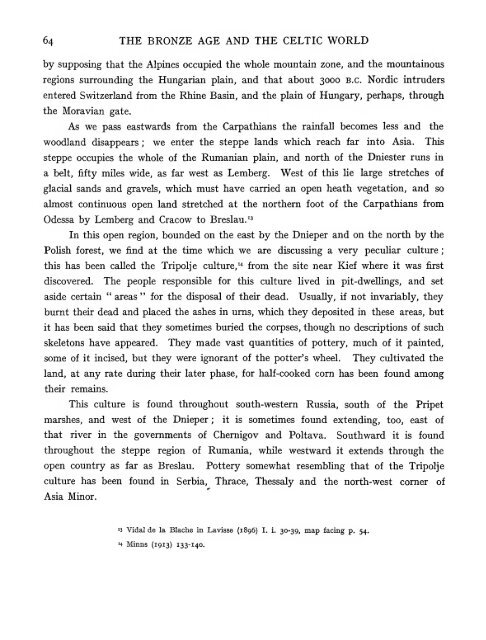The bronze age and the Celtic world - Universal History Library
The bronze age and the Celtic world - Universal History Library
The bronze age and the Celtic world - Universal History Library
You also want an ePaper? Increase the reach of your titles
YUMPU automatically turns print PDFs into web optimized ePapers that Google loves.
64 THE BRONZE AGE AND THE CELTIC WORLD<br />
by supposing that <strong>the</strong> Alpines occupied <strong>the</strong> whole mountain zone, <strong>and</strong> <strong>the</strong> mountainous<br />
regions surrounding <strong>the</strong> Hungarian plain, <strong>and</strong> that about 3000 B.C. Nordic intruders<br />
entered Switzerl<strong>and</strong> from <strong>the</strong> Rhine Basin, <strong>and</strong> <strong>the</strong> plain of Hungary, perhaps, through<br />
<strong>the</strong> Moravian gate.<br />
As we pass eastwards from <strong>the</strong> Carpathians <strong>the</strong> rainfall becomes less <strong>and</strong> <strong>the</strong><br />
woodl<strong>and</strong> disappears ; we enter <strong>the</strong> steppe l<strong>and</strong>s which reach far into Asia. This<br />
steppe occupies <strong>the</strong> whole of <strong>the</strong> Rumanian plain, <strong>and</strong> north of <strong>the</strong> Dniester runs in<br />
a belt, fifty miles wide, as far west as Lemberg. West of this he large stretches of<br />
glacial s<strong>and</strong>s <strong>and</strong> gravels, which must have carried an open heath vegetation, <strong>and</strong> so<br />
almost continuous open l<strong>and</strong> stretched at <strong>the</strong> nor<strong>the</strong>rn foot of <strong>the</strong> Carpathians from<br />
Odessa by Lemberg <strong>and</strong> Cracow to Breslau.'^<br />
In this open region, bounded on <strong>the</strong> east by <strong>the</strong> Dnieper <strong>and</strong> on <strong>the</strong> north by <strong>the</strong><br />
Pohsh forest, we find at <strong>the</strong> time which we are discussing a very peculiar culture ;<br />
this has been called <strong>the</strong> Tripolje culture,"* from <strong>the</strong> site near Kief where it was first<br />
discovered. <strong>The</strong> people responsible for this culture hved in pit-dweUings, <strong>and</strong> set<br />
aside certain " areas " for <strong>the</strong> disposal of <strong>the</strong>ir dead. Usually, if not invariably, <strong>the</strong>y<br />
burnt <strong>the</strong>ir dead <strong>and</strong> placed <strong>the</strong> ashes in urns, which <strong>the</strong>y deposited in <strong>the</strong>se areas, but<br />
it has been said that <strong>the</strong>y sometimes buried <strong>the</strong> corpses, though no descriptions of such<br />
skeletons have appeared. <strong>The</strong>y made vast quantities of pottery, much of it painted,<br />
some of it incised, but <strong>the</strong>y were ignorant of <strong>the</strong> potter's wheel. <strong>The</strong>y cultivated <strong>the</strong><br />
l<strong>and</strong>, at any rate during <strong>the</strong>ir later phase, for half-cooked corn has been found among<br />
<strong>the</strong>ir remains.<br />
This culture is found throughout south-western Russia, south of <strong>the</strong> Pripet<br />
marshes, <strong>and</strong> west of <strong>the</strong> Dnieper ; it is sometimes found extending, too, east of<br />
that river in <strong>the</strong> governments of Chernigov <strong>and</strong> Poltava. Southward it is found<br />
throughout <strong>the</strong> steppe region of Rumania, while westward it extends through <strong>the</strong><br />
open country as far as Breslau. Pottery somewhat resembhng that of <strong>the</strong> Tripolje<br />
culture has been found in Serbia, Thrace, <strong>The</strong>ssaly <strong>and</strong> <strong>the</strong> north-west corner of<br />
Asia Minor.<br />
'3 Vidal de la Blache in Lavisse (1896) I. i. 30-39, map facing p. 54.<br />
'4 Minns (1913) 133-140.







